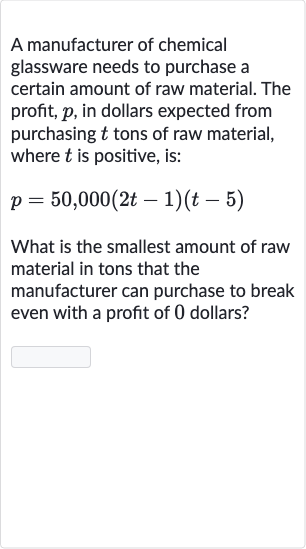AI tutor
Welcome to Bytelearn!
Let’s check out your problem:

A manufacturer of chemical glassware needs to purchase a certain amount of raw material. The profit, , in dollars expected from purchasing tons of raw material, where is positive, is:What is the smallest amount of raw material in tons that the manufacturer can purchase to break even with a profit of dollars?
Full solution
Q. A manufacturer of chemical glassware needs to purchase a certain amount of raw material. The profit, , in dollars expected from purchasing tons of raw material, where is positive, is:What is the smallest amount of raw material in tons that the manufacturer can purchase to break even with a profit of dollars?
- Set Profit Equation: To find the smallest amount of raw material in tons that the manufacturer can purchase to break even, we need to set the profit equation equal to and solve for .
- Divide by ,: Since the profit is multiplied by , we can divide both sides of the equation by to simplify the equation without affecting the value of .
- Solve Quadratic Equation: Now we have a quadratic equation in factored form. To find the values of that make the profit zero, we set each factor equal to zero and solve for .First, set the first factor equal to zero:
- First Factor Zero: Solve for by adding to both sides and then dividing by :
- Second Factor Zero: Now, set the second factor equal to zero:
- Valid Solutions: Solve for by adding to both sides:
- Compare Values: We have found two values of , and . Since represents the tons of raw material and must be positive, both are valid solutions. However, we are looking for the smallest amount of raw material to break even.
- Smallest Amount: Comparing the two values, ton and tons, we see that ton is the smaller amount. Therefore, the smallest amount of raw material the manufacturer can purchase to break even is ton.
More problems from Write exponential functions: word problems
QuestionGet tutor help
QuestionGet tutor help
QuestionGet tutor help
QuestionGet tutor help
QuestionGet tutor help
QuestionGet tutor help
QuestionGet tutor help
QuestionGet tutor help
QuestionGet tutor help
